
Chinese Medicine
This section covers various aspects of Chinese medicine, including Acupuncture, Tai Chi Chuan, Qigong, face reading, divination, energetic impact of food, herbal medicine, meditation, philosophy, etc.
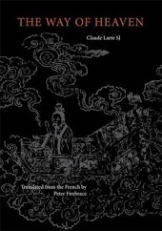
The Way of Heaven
Nei Jing Su Wen
chapters 1 & 2
Claude Larre (translation from the Yellow Emperor's Classic of Internal Medicine)
SYNOPSIS:
The Yellow Emperor's Classic of Internal Medicine, the Nei Jing, has been a source book for Chinese Medicine for 2000 years. The Way of Heaven is a translation of it's first two chapters, which still holds relevance for us today. Wide ranging in their aim and scope, these chapters represent a particular philosophy of health, emphasising the need to live in harmony with Heaven and Earth, in tune with natural cycles and life phases. Following the Way of Heaven is the key to health and vitality in its broadest sense and Losing the Way the root of all pathology, both on an individual and planetary level.
BRIAN'S VIEW:
This is a lovely book. As well as the actual discussions between Huang Di (the Yellow Emperor) and Qi Bo (the Heavenly Master), there is an interpretation of what to get from the conversation, as well as an introduction that sets the scene for the reader. This is a philosophical canon that informs a lot of other work.

The Web that has no Weaver
Ted J Kaptchuk
SYNOPSIS:
The Web That Has No Weaver is a classic and comprehensive volume that discusses the theory and practice of Chinese medicine. Kaptchuk’s book is an invaluable resource in the field and an authoritative guide that helps readers understand both Western and Eastern healing practices. Here in the revised edition is further research into ancient Chinese practices as well as active involvement in cutting-edge scientific research.
BRIAN'S VIEW:
This is a good serious introduction to the principles of Chinese Medicine. It is not a light touch 101 type book, but well worth putting the effort in if you want more of a good broad understanding.
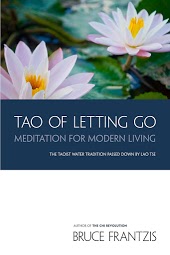
The Tao of Letting Go
Meditation for Modern Living
Bruce Frantzis
SYNOPSIS:
What is known from the Tao Te Ching, I Ching, and other Taoist texts is almost entirely literary. When Bruce Frantzis studied these texts with his main teacher, Grandmaster Liu Hung Chieh, he was taught their practical application: "This is what they say; this is what they mean; this is how to do them." In theTAO of Letting Go, Frantzis offers a bridge to this pragmatic approach for living a spiritual life. Spirituality is not just an aspiration for which people strive, he says, but a genuine, accomplishable reality.
Frantzis shows how to expend maximum effort and yet not use force--the gentle way of the Water method--to enrich personal health and energy systems. The Water tradition continues the work of releasing inner conflicts, a process that begins with the Dissolving Method, passed down by Lao Tse in the Tao Te Ching over 2,500 years ago. The author shows how to completely let go of the blockages that bind and prevent the seeker from reaching full spiritual potential. Short, direct chapters and exercises cover such topics as breathing and awareness; Taoist meditation; fog and depression; modern anxiety; love and compassion; and more.
BRIAN'S VIEW:
This is a really practical, simple to follow book on relevant meditational practice for modern life. Just do it!

Opening the Energy Gates of Your Body
Bruce Frantzis
SYNOPSIS:
Opening the Energy Gates of Your Body explains the practice of chi gung (qigong), where you can learn to activate your chi to improve health, reduce stress and reverse the effects of aging. This edition includes Longevity Breathing methods; how cross-training in chi gung can enhance other exercises such as yoga, golf and weight training; and nei gung techniques for advanced practitioners. Frantzis' thorough knowledge of energy arts and the Chinese language allow him to peel away the secrecy and metaphors. Opening the Energy Gates of Your Body includes a comprehensive guide to chi gung theory and a systematic lesson plan with more than 100 illustrations. These low-impact exercises are suitable for almost any age or fitness level. They provide the foundation for learning any other chi practice, such as tai chi, martial arts, meditation or Taoist Yoga. Frantzis explains not only how these inner aerobics are done, but why. Going beyond mere body movement, he teaches from the inside out, linking the biomechanics and anatomy of the physical body with the subtleties of chi. This book provides practical methods to help people become balanced, relaxed and joyful. Practicing chi gung or tai chi is one of the most effective ways people can reclaim control of their health and well-being.
BRIAN'S VIEW:
Another easy to understand book to suit beginners, with enough meaty detail and depth for the advanced martial artist, healer or meditator, from breathing, getting aligned, opening the energy gates, Cloud Hands & spiralling, the three swings, taoist spine stretch, etc. Once you have these basics, you move to Nei Gong practice where you take the intellectual knowledge& put it into practice & feeling the Qi.
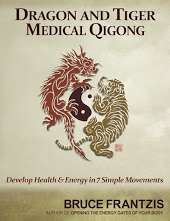
Dragon and Tiger Medical Qigong
Volume 1
Bruce Frantzis
SYNOPSIS:
Dragon and Tiger qigong uses simple body movements to accomplish the same chi balancing as acupuncture. Each movement is designed to stimulate not just a single meridian but groups of meridians. In Chinese medicine, the tiger is a metaphor for a strong, healthy liver and powerful muscles, and the dragon is a metaphor for healthy and strong lungs. The Dragon and Tiger form accomplishes three major changes in the body necessary for healing: it releases stagnant chi energy; increases the speed, strength, and evenness of the circulation of chi, blood, and other fluids; and quickly raises the body’s energy levels to boost its natural healing capacities. With over 150 illustrations accompanying clear, thorough instructions, Dragon and Tiger Medical Qigong offers an accessible and effective path to health and healing.
BRIAN'S VIEW:
Dragon & Tiger qigong may seem complicated initially, but once you have the basics down from following a teacher, this book provides detailed, easy to follow guidance to get the most out of this excellent qigong set. As with all of Bruce's books, it is well written and easy to follow. The history is interesting as well.
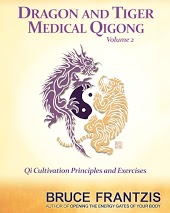
Dragon and Tiger Medical Qigong
Volume 2
Bruce Frantzis
SYNOPSIS:
Dragon and Tiger Medical Qigong: Volume 2 teaches how to cultivate and direct the flow of qi in the body and make the feeling of qi tangible. Qi, or "internal life-force energy," is the foundation of acupuncture and all Chinese medicine. The stronger the qi moves, the greater the health benefits of qigong will be. Once the feeling of directing qi becomes tangible, the principles can be applied to other internal martial arts such as tai chi and other qigong practices. Practitioners of healing arts will find this book invaluable as a means for becoming sensitive to qi energy in themselves and others. Healers will also learn how to get rid of stagnant qi buildup and thereby avoid burnout when working with other people's energy.
BRIAN'S VIEW:
Volume 1 teaches the physical movements and transitions, whilst volume 2 really gets into the meat of sensing and working with your Qi. A lot of it will be familiar to those attending Steve's classes.
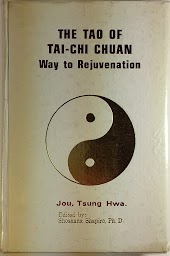
The Tao of Tai-Chi Chu'an
Jou, Tsung Hwa
SYNOPSIS:
In The Dao of Taijiquan, the author, Jou, Tsung Hwa, himself bears witness to the ability of Tai-Chi to relieve the body of pent-up tension and rejuvenate the spirit in a thorough study of the techniques and classical texts of this ancient martial art. In order to create a serious textbook that explains the philosophy behind the movements of tai chi chuan, he read all available books in both English and Chinese before writing The Dao of Taijiquan.
The drawings of the three classical styles (Chen, Yang and Sun) are taken from other books written in Chinese. Sections of Tai Chi Chigung and push hand are translated from a Chinese Tai Chi book written by Chen Yenlin. The author also translated the Tai Chi Classics with his own commentaries.
BRIAN'S VIEW:
This book is a must for any serious Tai Chi player. Although words cannot explain the experience of Tai Chi just like one cannot describe what sugar tastes like, the book offers some practical tips and scientific perspective. He introduces the 'Master Key' i.e. the key philosophies one needs to study to get the most out of Tai Chi - these being the I Ching, the Eight Trigrams and the Five Elements. This was a key learning for me, having studied each separately but never thought to bring them together - more work required!
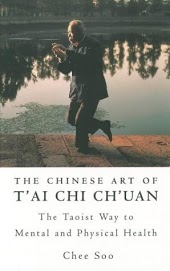
The Chinese Art of T'ai Chi Ch'uan
Chee Soo
SYNOPSIS:
T'ai Chi is the embodiment of the ancient Chinese philosophy of Taoism with a history dating back over three thousand years. Through the cultivation of the natural internal energy of the body or 'Chi' T'ai Chi exercises improve the health and increase vitality by aiding the regeneration of the body whilst creating a deep feeling of peace and relaxation in the mind. Chee Soo sets Tai Chi in its philosophical and historical context, intrdoucing different aspects of the art. As well as all 140 moves of the Lee style form with photos and discriptions, he introduces Tai'Chi Sword, Flying Hands, (the Dance) as well as push hands, and whirling arms.
BRIAN'S VIEW:
This is a nice introduction to Tai Chi, as well as a useful guide for those already studying Lee Style with a teacher. The photos and descriptions are sufficient to cover gaps when learning the form - feet placement & stepping, arm movements and transitions.
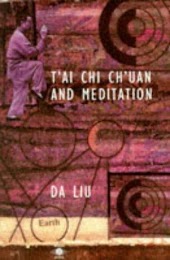
T'ai chi ch'uan and meditation
Da Liu
SYNOPSIS:
An ideal introduction to T'Ai Chi Ch'Uan, providing clear descriptions of the methods of meditation and exercise, and illuminating the underlying theory, so readers can understand as well as practice the techniques in their daily routine. The book shows how the physical and the spiritual can be balanced by combining the arts of meditation and Tai Chi movement.
BRIAN'S VIEW:
This is a high level introduction to Tai Chi basics - doesn't go into a lot of detail but covers a broad range sufficient to whet the appetite. I haven't learned anything new from this book, however it did offer some new insights philosophical insights into what I've already studied.
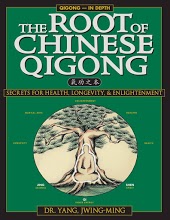
The Root of Chinese QiGong
Jang, Jwing Ming
SYNOPSIS:
T'ai Chi is the embodiment of the ancient Chinese philosophy of Taoism with a history dating back over three thousand years. Through the cultivation of the natural internal energy of the body or 'Chi' T'ai Chi exercises improve the health and increase vitality by aiding the regeneration of the body whilst creating a deep feeling of peace and relaxation in the mind. Chee Soo sets Tai Chi in its philosophical and historical conext, and introduces the different aspects of the art, including T'ai Chi Sword and T'ai Chi Dance. All 140 moves of Lee Style Tai Chi are illustrated with photographs and detailed descriptions.
BRIAN'S VIEW:
This is an excellent book to get a broad understanding of Qi & how it fits with the chinese medicine paradigm. As well as some history, you are introduced to the three Treasures Jing, Qi & Shen, relaxation & rooting, regulating the breath, mind, essence, qi & spirit, the major vessels and the extraordinary vessels. There are plenty of practical tips.
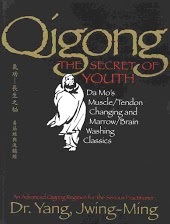
Qigong The Secret of Youth
Jang, Jwing Ming
SYNOPSIS:
For over one thousand years, Bodhidharma's (Da Mo) timeless classics have been considered the key to enlightenment and long-lasting youth. Now, Dr. Yang, Jwing-Ming, one of the world's leading authorities on Qigong, has translated and written commentaries to make these ancient and profound teachings accessible to everyone. Using ancient Buddhist and Taoist documents as its foundation, this book analyzes and discusses theory and training methods in a modern, scientific manner, and presents safe ways for you to begin your own practice.Improve your health and strength through the Yi Jin Jing (Muscle/Tendon Changing Classic). Work towards longevity & enlightenment with the Xi Sui Jing (Marrow/Brain Washing Classic). Qigong, the Secret of Youth is an invaluable guide for Qigong practitioners and Martial Artists who want to explore deeper levels of internal energy training.Learn the keys to rejuvenating & reconditioning your body.Discover methods for nourishing the brain and bone marrow.Includes Qigong exercises & massage techniques.
BRIAN'S VIEW:
Not for the beginner, or even a student with several years training to attempt without guidance from an informed practitioner. Some good history and useful theory, but there are practices which some consider dangerous without years of prior training (Bruce's words, not mine).
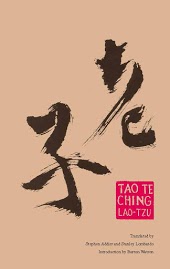
Tao Te Ching
Lao-Tzu
Translated by Stephen Adidd and Stanly Lombardo
SYNOPSIS: T
his translation captures the terse and enigmatic beauty of the ancient original and resists the tendency toward interpretive paraphrase found in many other editions. Along with the complete translation, Lombardo and Addiss provide one or more key lines from the original Chinese for each of the eighty-one sections, together with a transliteration of the Chinese characters and a glossary commenting on the pronunciation and meaning of each Chinese character displayed. This greatly enhances the reader's appreciation of how the Chinese text works and feels and the different ways it can be translated into English
BRIAN'S VIEW:
This is a lovely book to read slowly. Read a chapter at a time, contemplate possible meanings and admire the chinese graphics.
squares.
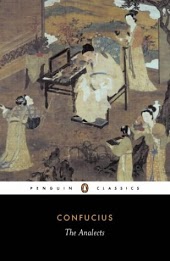
Confucius The Analects
Collated by his students
Translated by D.C. Lau
SYNOPSIS:
The Analects express a philosophy, or a moral code, by which Confucius, one of the most humane thinkers of all time, believed everyone should live. Upholding the ideals of wisdom, self-knowledge, courage and love of one's fellow man, he argued that the pursuit of virtue should be every individual's supreme goal. And, while following the Way, or the truth, might not result in immediate or material gain, Confucius showed that it could nevertheless bring its own powerful and lasting spiritual rewards.
BRIAN'S VIEW:
OK, this isn't an easy read, but if you persevere you wil begin to see why Confucius' sayings have stood the test of time and are equally applicable today. The introduction is helpful, as are the explanatory notes along the way.
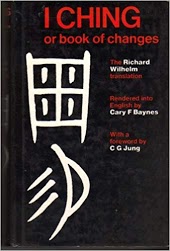
I Ching or book of changes
The Richard Wilhelm translation, rendered into English by Cary F. Baynes with foreword by Carl Jung
SYNOPSIS:
At least 5000 years old, the I Ching is a book of oracles containing the whole of human experience. Used for divination, it is a method of exploring the unconscious; through the symbolism of its hexagrams we are guided towards the solution of difficult problems and life situations. It can also be read as a book of wisdom revealing the laws of life to which we must all attune ourselves if we are to live in peace and harmony.
BRIAN'S VIEW:
Again not the easiest of reads, but the transliteration and rendering into English probably bring one as close to how one imagines the Chinese text to be. I tend to use this along with Sarah Denning's book to add a little more detail.
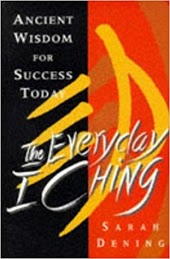
The everyday I Ching - ancient wisdom for success today.
Sarah Denning
SYNOPSIS:
The "I Ching" is an ancient Chinese manual of divination. It shows how to predict change according to the way three coins fall, heads or tails, in six successive throws. Each sequence corresponds to a hexagram which gives guidance on how to take the correct action in a particular situation.
BRIAN'S VIEW:
This is a very practical book to assist you in making decisions where the best course of action is unclear. It isn't a book about fortune telling, nor a substitute for common sense. Be sincere as you compose your questions and you will receive insightful guidance. If it comes out gibberish, you probably didn't frame the question well enough or weren't in the right frame of mind to seek guidance.




